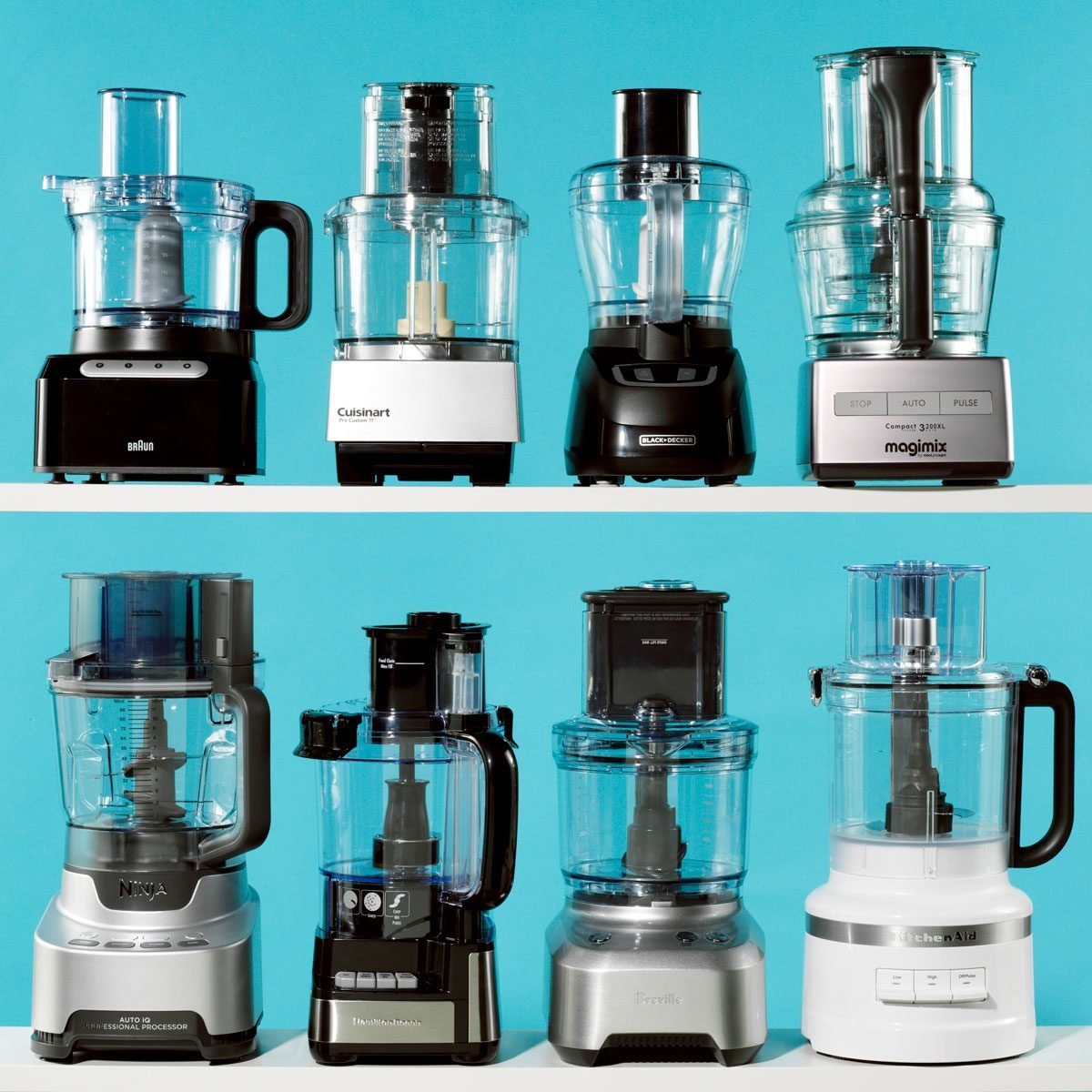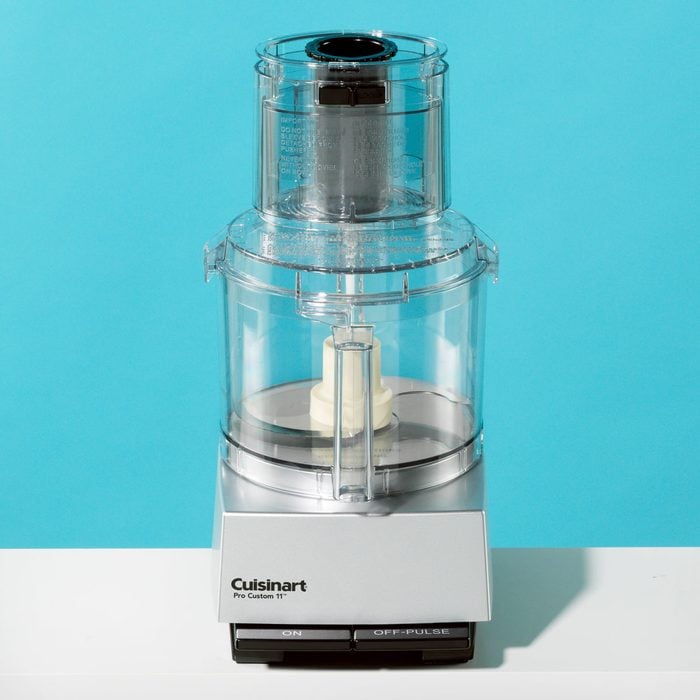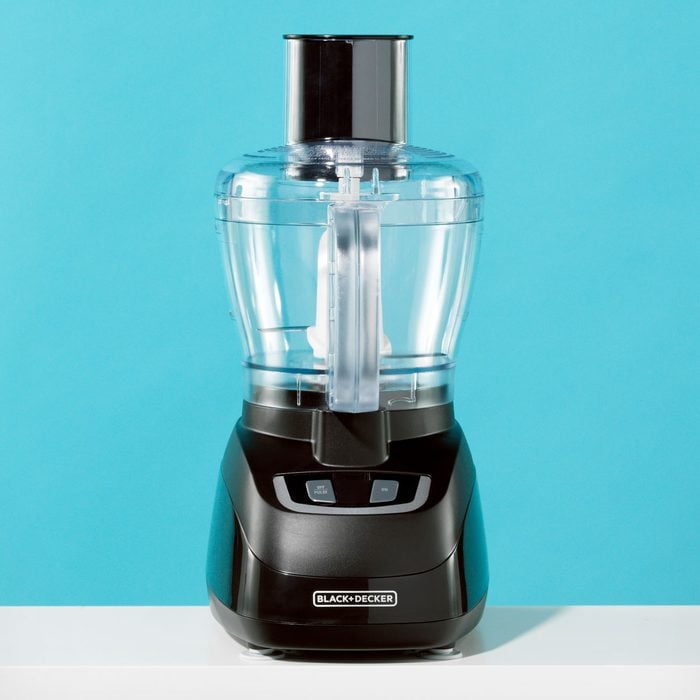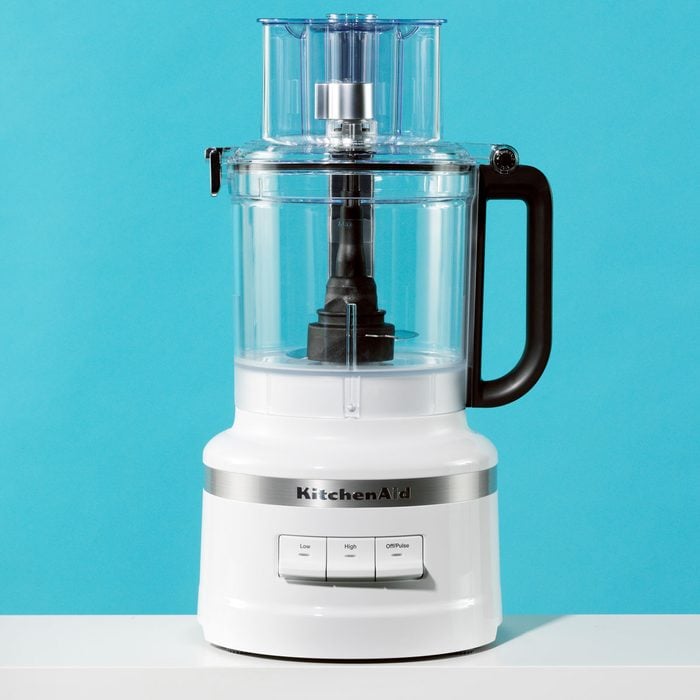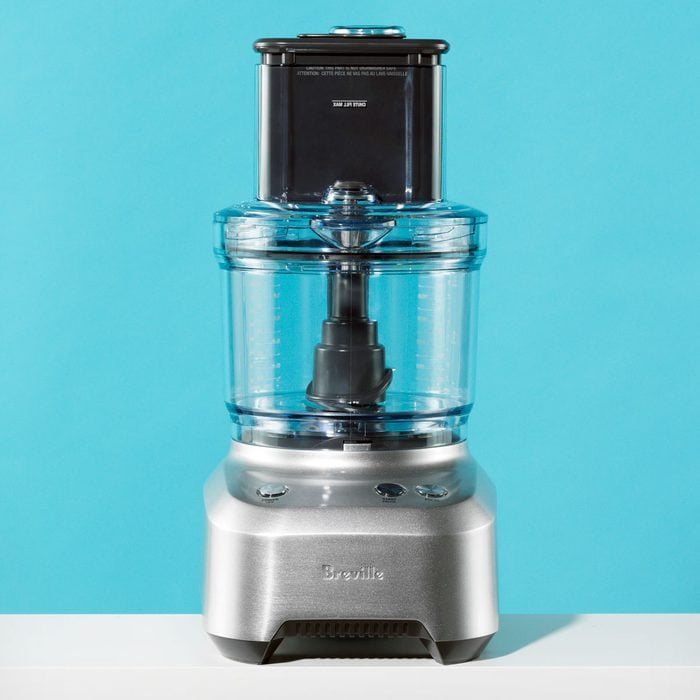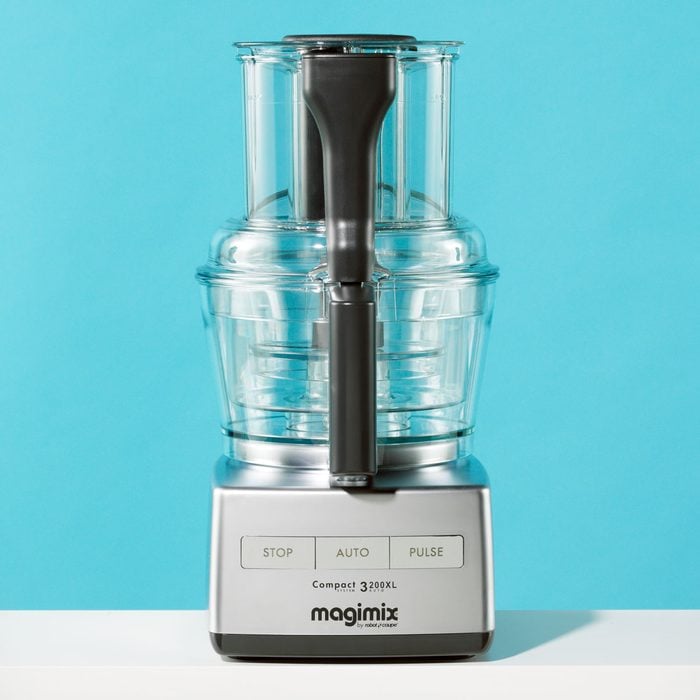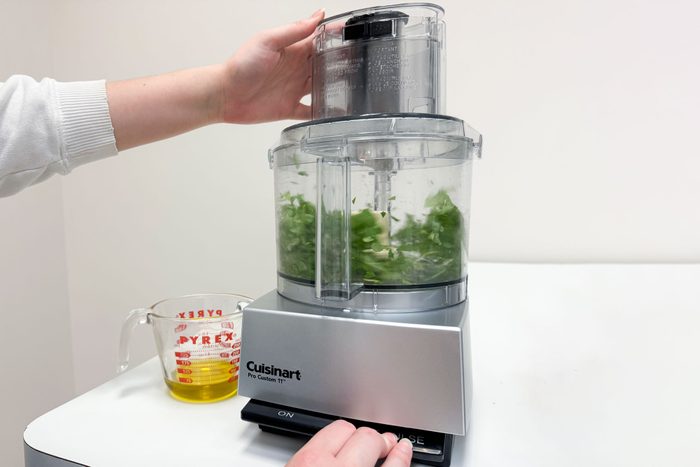Taste of Home
Taste of Home
Pros:
-
Easy to assemble and use
-
Slicing disc and two shredding discs
-
Multi-purpose blade, dough blade, dicing kit and French fry disc included
-
Chops uniformly
-
Rubber circles prevent slips
-
Storage caddy included
Cons:
-
Fairly tall and difficult to store
-
Feeder tube is rather small
Capacity: 13 cups | Settings: Low, High, Off/Pulse | Power: 500 watts | Size: 8.75 x 10.25 x 17.44 in. | Weight: 8.35 lbs. | Cord length: 31.5 in. | Warranty: 1-year limited warranty | Dishwasher safe: All parts are top-rack, dishwasher-safe
Some home cooks just need a reliable machine that chops evenly, and that’s about it. Enter the KitchenAid 13-Cup Food Processor. This reliable appliance offers some of the most even slices, dices and chops of the group. Plus, there’s a number of attachments available for fancier home cooks, from slicing and shredding disks to dough blades, dicing kits and even a French fry slicing disk. Despite that, it’s easy and intuitive to whip up food processor recipes quickly and efficiently with this tool.
Despite the multitude of functions available, our Product Testing Team noted that assembling and operating the machine is incredibly intuitive. Once assembled it’s rather tall, so we recommend storing it in 2-3 pieces rather than fully snapped together. It does come with a helpful storage caddy—a nice extra. However, the team did have difficulty figuring out where each piece fits. Folks may prefer using their own organizers instead.
TASTE OF HOME
While running, rubber feet underneath the appliance prevent slips and sliding. Six adjustable thickness settings makes short work of veggies, whether a thicker cut or a paper-thin slice. The feeder tube may feel a little small for larger veggies like heirloom tomatoes and oversized potatoes, but cutting up produce before feeding it in easily solves this issue. We found the extra work worth it, especially given how precisely the machine chops and dices.
Taste of Home
Taste of Home
Pros:
-
Sleek and durable design
-
Two disks, blender mix, whisk, and two metal blades
-
Three different bowl sizes
-
Includes motor guarantee certificate
-
Includes recipe book
-
Spatula and storage box
-
Thermal failsafe feature
-
Operates quietly
Cons:
-
Quite pricey
-
Not easy to put together
Capacity: 12 cups | Settings: Stop, Auto, Pulse | Power: 650 watts | Size: 7.5 x 9 x 15.5 in. | Weight: 15.65 lbs. | Cord length: 45 in.| Warranty: 30-year guarantee for base and 3-year for parts | Dishwasher safe: Detachable parts can go in top rack of dishwasher
On the other end of the pricing spectrum is the Magimix 12-Cup Cuisine System, which rings up at nearly ten times the cost of the Black + Decker model. While we won’t shy away from calling this option expensive, it certainly earns its place as the best splurge option thanks to a number of luxe features and attachments. Plus, no budding chef can deny that this one offers the best aesthetics of the bunch!
At first touch, our Product Testing Team notes that this food processor should easily last through years of daily use. Consistent slices across the board—paired with a 15-pound mass that prevents slipping—give this sleek and sexy unit an edge on competitors. Whisk and blender mix attachments offer additional versatility in the kitchen. Those that prefer to process their own meat deliveries or who require even portions for entertaining will find it worth the hefty price tag.
The robust build comes fitted with a thermal failsafe. This function automatically switches the motor off when it’s overloaded or runs too long. Accompanying this food processor is a whopping 30-year warranty guarantee for the base and a motor guarantee certificate, which solidifies this as a worthy investment.
TASTE OF HOME
What to Look for When Buying a Food Processor
As Catherine mentioned, food processors are an integral appliance for any kitchen, meaning you’ll want to snag one that lasts for year to come. In addition to longevity, she recommends shopping around for food processors with a few specific features. “I want a food processor with a heavy enough base that it sits firmly on the counter without jumping around when processing firmer foods like hard cheeses and carrots,” she says.
Additionally, Catherine recommends seeking out an option with a variety of blades for chopping, slicing and shredding. “A big plus would be adjustable blades for slicing varied thickness,” she says. For some home cooks, this may not be as important of a factor, especially for those who own one of the best chef’s knives. However, we feel that the more functionality in an appliance, the better—assuming it doesn’t affect performance.
Why You Should Trust Us
Our Product Testing Team has a combined decade of experience with testing and evaluating products. We conducted all tests in our Product Testing Lab under controlled conditions in order to best rate each processor’s performance. We spent an estimated 40 hours on this test, including researching, sourcing, intaking and testing the products.
For this piece we also consulted food processor expert Catherine Ward. A lifelong foodie, Catherine Ward heads up the Taste of Home prep kitchen. She also lends her expertise for articles about cooking and baking techniques, as well as kitchen tools. Catherine has worked in the hospitality industry for most of her career, catering and teaching cooking classes. She is happiest when she’s cooking for a table full of friends and family.
How We Found the Best Food Processor
First, we combed through stores popular with Taste of Home readers, including Walmart, Amazon and Sur La Table. From there, we identified top-selling food processors from each retailer, focusing on those with the best reviews and brand reputations. Once we narrowed down our list, we picked eight different food processors from eight different brands, focusing on a variety of options and price points that suit a diverse set of kitchen needs.
To test out each pick, we set up our Product Testing Lab with everything needed: cheese, tomatoes, walnuts and ingredients for salad dressing (oil, herbs and lemon juice). Once assembled, we conducted our evaluations, focusing on the factors below:
Setup and Assembly
Testers read through each instruction manual, then set up each food processor. We noted how straightforward, intuitive and simple it is to attach and swap out the various parts.
Specs, Construction and Appearance
For this category, we measured the length of each cord, weighed each food processor (including base, bowl and standard blade). From there, we assessed how loudly, comparatively, the machine runs while operating. This category also includes considerations like whether each pick fits under cabinetry and on storage shelves, whether it slides or scoots while running, if it feels durable, and any safety features included. Lastly, we looked at the aesthetics of each.
Performance
TASTE OF HOME
One of the most important aspects of a food processor is heartiness and whether it withstands hard foods (and foods that are more difficult to process). “I look for components to be solid—not thin and flimsy—that will hold up over time without breaking,” says Catherine.
In order to test for this, we used a block of chilled mozzarella. While many of the manuals recommended against using soft cheeses like mozzarella, we decided to use a block of adequately chilled cheese as a stress test. Some machines still performed better than others, so we feel the test is a good indicator on overall performance.
TASTE OF HOME
Each processor chopped walnuts, with the testers observing the uniformity of the pieces. In addition, each machine sliced tomatoes, after which we observed how thinly the machine successfully sliced them. We also noted whether the tomato requires cutting before adding it into the feeder tube. Testers then supplied the machine with garlic, herbs, lemon juice and oil to see how well the mixture blends and incorporates the oil. The final test involved checking how well pastry dough forms for pie bakers.
We also rated blade sharpness on a scale of 1-5 and noted whether items first require chopping before they’ll fit in the feeder tube. Testers also checked the quickness of the blade response when changing settings and whether adding oil to the machine is possible while running it.
Cleaning and Disassembly
TASTE OF HOME
Testers disassembled and hand-washed each food processor, noting the difficulty of the cleaning process as well as which parts, if any, can optionally go into a dishwasher.
Value
Value is the final consideration. Testers looked at each pick’s score, pros and cons, then looked at the cost. We noted whether or not each is worth the price, which indicates its value. Any warranty information also falls into this category. Lastly, we noted who each pick is best for (e.g. home cooks, the elderly, budding chefs, etc.).
FAQ
TASTE OF HOME
What is the best food processor for making bread?
Food processors can make excellent bread baking tools. When looking for a food processor for making bread, consider snagging an option that can withstand the grueling mixing process. In our testing, the Cuisinart 11-cup food processor performed the best with pastry dough. It did a good job fully incorporating all the ingredients—no flour buildup or big chunks of butter. Once we dumped it out, it formed into a ball easily as well.
What is the difference between a food processor vs blender?
Typically used for “wet” recipes like smoothies, blenders typically have a single blade and are longer and narrower than food processors. Usually, folks use blenders to—well—blend. On the other hand, food processors work best for chopping, mixing and slicing.
Can a food processor crush ice?
While some food processors crush ice without issue, some simply aren’t robust enough. Ice cubes are incredibly hard, meaning that it’s important to ensure that your food processor is up to the task—or risk breaking it. Always check the manufacturer’s manual before using ice in a food processor. Instead, consider a specialty ice cube tray or the Beast blender, which easily tackles ice cubes.
